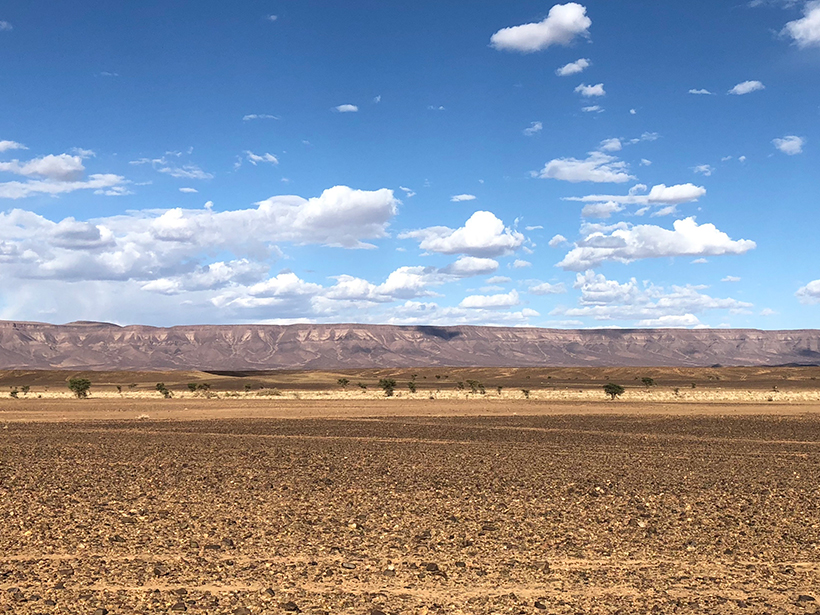Thanks to the presence of iron, the Fezouata Shale in southern Morocco is one of only a handful of regions around the world where soft-bodied creatures have been fossilized and the only location with fossils originating from the Early Ordovician.
Previous studies have linked iron to soft-bodied fossil preservation, and research published in Geology suggests that Earth’s orbit was partially responsible for the presence of iron in the rocky outcrop of the Fezouata.
Fossilization preferentially preserves hard substances, like bones and shells, making soft-bodied creatures from the past harder to come by. Only a few hundred million years after the Cambrian Explosion dramatically increased the various types of life on Earth, the Great Ordovician Biodiversification Event saw the diversity of marine invertebrates rise dramatically. But the spineless creatures of the Ordovician period were rarely captured as fossils.
The unique nature of the Fezouata Shale may be due to the planet’s orbit.
Since its identification in the late 1990s, the Fezouata Shale has yielded a wealth of exceptionally preserved soft-bodied fossils, making it one of the rare sites documenting the early stages of the Great Ordovician Biodiversity Event. This unique nature of the Fezouata Shale may be due to the planet’s orbit.
Earth’s orbit gradually changes from being nearly circular to elliptical over a period of about 100,000 years, a pattern known as orbital eccentricity. At the extreme end of the ellipse, when the planet is farthest from the Sun, seasonal variations are amplified, leading to more rain and snow, which in turn weather rocks on Earth’s surface.
“We need precipitation to erode and alter the continental rocks,” said Farid Saleh. Saleh, a graduate student at Claude Bernard University in Lyon, France, studied the minerology of sediments in the outcrop to see how common the iron might be.
Iron is rich in the Fezouata Shale, scrubbed from the surrounding rocks and carried to the hillside. Some of the iron formed berthierine, a mineral recently shown to inhibit the breakdown of soft tissues and promote their fossilization.
“The soft tissues that usually decay the fastest in nature, their decay was slowed down,” Saleh said.
At the same time, some of the iron became pyrite, replicating the internal organs of the corpses of the creatures around it and preserving the shapes of their soft bodies in the rock.
Orbital Eccentricity as an On-Off Switch
Saleh found that the iron-rich layers of fossilization in the Fezouata Shale cycled over 100,000 years, a period that corresponds to the eccentricity of Earth’s orbit.
“It’s kind of like an on-off switch,” said Daniel Horton of Northwestern University in Evanston, Ill., who was not part of the research.
“We have more extremes in the climate system that may lead to the better preservation of fossils.”
According to Horton, who has studied how Earth’s eccentricity affected climate change in other eras, a more eccentric orbit can lead to enhanced weathering. “We have more extremes in the climate system that may lead to the better preservation of fossils,” he said.
Planetary scientist Arthur Adams of Yale University also said that a small change in orbit can have “a pretty drastic effect.” Adams, who models the effect of eccentricity on ocean worlds around other stars, said that climate changes can potentially vary quite dramatically, depending on how elliptical the orbit is. That variation, in turn, could lead to increased precipitation.
“I could certainly see that having a major effect,” Adams said.
Saleh, who has visited the Fezouata Shale several times, said that the rocks appear to be homogeneous, with no apparent visual pattern to distinguish the cyclical periods. Only after chemically analyzing the sediments did he detect variations in their mineralogical signatures, revealing the iron that would, at specific intervals, preserve the forms of soft-bodied creatures for millions of years.
“Animals living in this environment had more chances to be preserved,” Saleh said.
—Nola Taylor Redd (@NolaTRedd), Science Writer
Citation:
Redd, N. T. (2019), Earth’s eccentric orbit helped preserve rare soft-tissue fossils, Eos, 100, https://doi.org/10.1029/2019EO121853. Published on 26 April 2019.
Text © 2019. The authors. CC BY-NC-ND 3.0
Except where otherwise noted, images are subject to copyright. Any reuse without express permission from the copyright owner is prohibited.

